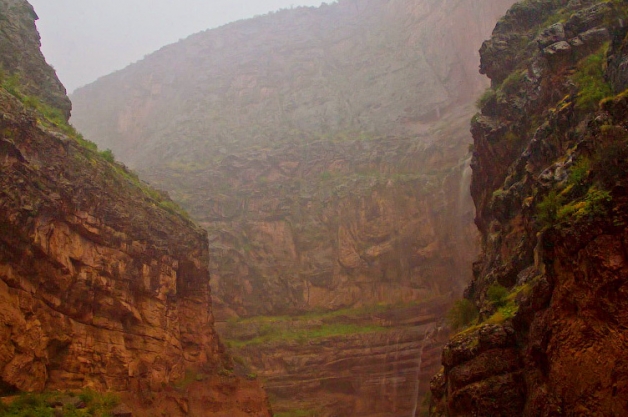Derbent Canyon, Baysun, Uzbekistan
Derbent (Darband) is a colorful kishlak in Uzbekistan, located in the Baysun, Surkhandarya region. The distance from Baysun is 30 km, from Termez – 130. It is famous for the natural attraction of the same name - the canyon in the southwestern part of the Hissar Mountains. Darband from Persian means belt, closed gate, gorge - and the kishlak is spread out, a narrow strip. The Sherabad River embodies the expression water sharpens a stone - for millions of years, its turbulent streams have made their way through the rocks, forming a canyon.
The Derbent Gorge has repeatedly acted as a defender of the ancient Bactrian land. The height of its cliffs reaches 400 meters - insurmountable for enemy arrows, but the approaching army can be seen in the palm of your hand. The length is 8 km, of which two kilometers of the road bind the traveler with stone vises tapering to 15 meters. The sun manages to illuminate to the ground every corner directed deep into the Hissar Mountains only by noon. Rugged terrain is another strategic advantage of the gorge in military affairs. According to the chronicles, the Derbent Gorge served as an obstacle to Alexander the Great himself, where the locals managed to restrain his onslaught for a long time.
Here, to the west, is the Iron Gate, once known to every merchant who wanted to send caravans along the Silk Road. They were even written about in Chinese, Arabic, and Turkic sources because there was no more comfortable way to get out of Samarkand towards Termez and Pamir, reducing the travel time. Appreciating their luck as a transit route, Derbent residents immediately found a way to capitalize on such an advantage by building a fortress and organizing a paid passage through the mountain pass for merchants.
According to legend, the nearby "Sogdian Rock" became a refuge during the siege for the family of Roxana, the future wife of Alexander the Great.
Derbent Canyon is a sacred place of pilgrimage for residents, drawn here to the holy spring and to worship the grave of Saint Khujamoy-ota. It is crowded here on the feast of the sacrifice of Kurban-Hait – it is believed that through the prayers of the saint, the Almighty will see the good deed you have done faster.
In the center of the canyon itself, another curious attraction has formed. It's about Kaptarkhon Canyon, which has become home to thousands of wild pigeons!
Located here, near the Machai kishlak, the famous grotto of the Teshik-Tash cave with the discovered in 1938 burial of a child of the Neanderthal period is an object of attraction for historians and anthropologists.









